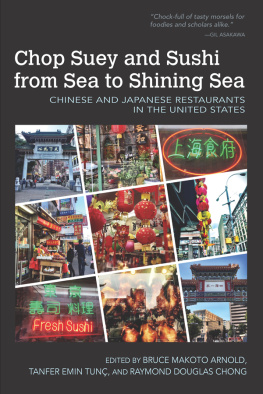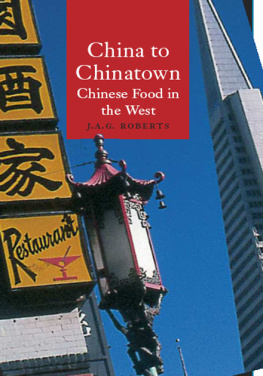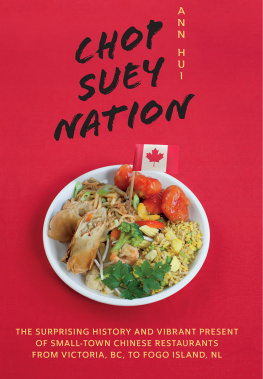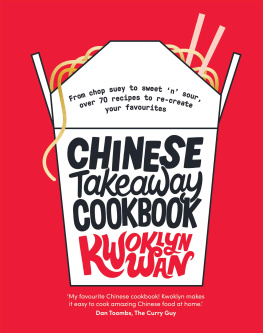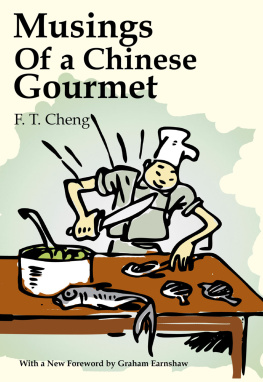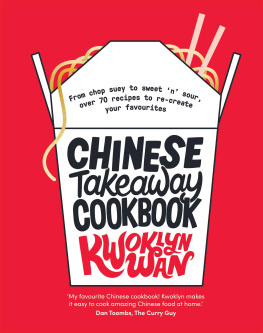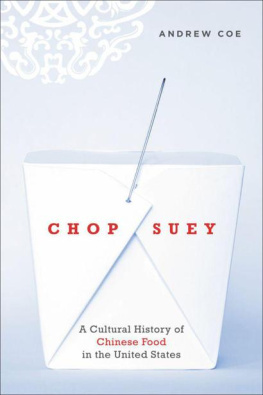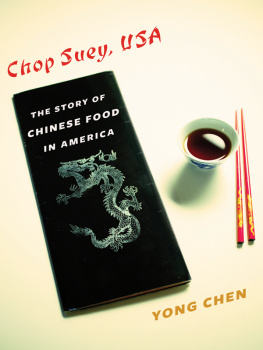Chop Suey
Chop Suey
A Cultural History of Chinese
Food in the United States
Andrew Coe


Oxford University Press, Inc., publishes works that further
Oxford Universitys objective of excellence
in research, scholarship, and education.
Oxford New York
Auckland Cape Town Dar es Salaam Hong Kong Karachi
Kuala Lumpur Madrid Melbourne Mexico City Nairobi
New Delhi Shanghai Taipei Toronto
With offices in
Argentina Austria Brazil Chile Czech Republic France Greece
Guatemala Hungary Italy Japan Poland Portugal Singapore
South Korea Switzerland Thailand Turkey Ukraine Vietnam
Copyright Andrew Coe 2009
Published by Oxford University Press, Inc.
198 Madison Avenue, New York, NY 10016
www.oup.com
Oxford is a registered trademark of Oxford University Press
All rights reserved. No part of this publication may be reproduced,
stored in a retrieval system, or transmitted, in any form or by any means,
electronic, mechanical, photocopying, recording, or otherwise,
without the prior permission of Oxford University Press.
The Library of Congress Cataloging-in-Publication Data
Coe, Andrew.
Chop suey : a cultural history of Chinese food in the United States
/ Andrew Coe.
p. cm.
Includes bibliographical references and index.
ISBN 978-0-19-533107-3
1. Cookery, Chinese. 2. Food habitsUnited StatesHistory. I. Title.
TX724.5.C5C64 2009
641.5951dc22 2008054664
9 8 7 6 5 4 3 2 1
Printed in the United States of America
on acid-free paper
TO JANE
CONTENTS
ACKNOWLEDGMENTS
This journey into the less-charted realms of Chinese and United States history could not have been accomplished without the assistance of many individuals and institutions. During the seemingly endless research phase of this project, I depended on the collections, staff, and resources of the New York Public Library: the Humanities and Social Sciences Library, particularly its Asian and Middle Eastern Division, and the Chinese Heritage Collection at the Chatham Square Branch Library. I also consulted the Nixon Presidential Library, the National Archives at College Park, Maryland, and the magnificent Dr. Jacqueline M. Newman Chinese Cookbook Collection housed in the Special Collections and University Archives of the Frank Melville Jr. Memorial Library of the State University of New York, Stonybrook. I am indebted to a Linda D. Russo Grant from the Culinary Trust for allowing me to visit the Bancroft Library at the University of California, Berkeley, and the Chinese Historical Society of America. The exhibition Have You Eaten Yet? The Chinese Restaurant in America at the Museum of Chinese in the Americas was one of the inspirations for this book. During the writing phase of this project, I relied on the staff and workspaces of the New York Mercantile Librarys Writers Studio and the New York Society Library. For assistance during all phases of this project, I am grateful to Richard Snow, Magnus Bartlett, Andrew Smith, Anne Mendelson, Harley Spiller, Jakob Klein, Anthony Chang, Charles Perry, H. Mark Lai, Madeline Y. Hsu, Harold Rolnick, Stella Dong, Paul Mooney, Eileen Mooney, Kenny of the Bronxs Golden Gate restaurant, Jacqueline Newman and Flavor & Fortune, Aaron and Marjorie Ziegelman, and, for technical support, my father, Michael D. Coe. Dwight Chapin, Charles Freeman, and Winston Lord generously granted me interviews on which I drew for the section on Nixons China trip. Joanna Waley-Cohen and John Eng-Wong were indefatigable readers who gave me greatly needed perspective. At Oxford University Press, my editors Benjamin Keene and Grace Labatt were painstaking and patient. And thanks to my sons Buster and Smacky for loving Chinese food and usually letting me work.
LIST OF ILLUSTRATIONS
Chop Suey
CHAPTER ONE
Stags Pizzles and Birds Nests
On a frigid morning in February 1784, the Empress of China set sail from New York harbor. It was embarking on the most ambitious expedition yet attempted by a United States vessel. At the helm stood Captain John Green, a pugnacious six-foot-four-inch veteran of the Continental navy, with many passages to Europe and the Caribbean under his belt. For this trip, he couldnt count on that experience. His only guide would be a British pilots manual that listed what little was known about the reefs and shoals, ports and trade winds his ship would encounter on the journey. If she survived, Captain Green estimated the voyage would take over a year, perhaps as much as two. The Empress of China was setting out on the first American trip to China, the eras equivalent of the 1969 journey to the Moon.
As the ship emerged onto the open Atlantic, its timbers creaked and groaned under the weight of its cargo. Barrels in the hold carried almost $20,000 in Spanish silver and thirty tons of dried ginseng root from the mountains of Pennsylvania and Virginia. The Empresss owners, some of the young nations most powerful businessmen, hoped to trade the silver and the ginseng for the tea, silks, and porcelain of China. To sustain the ships forty-two-man crew, Captain Green had filled every remaining space both below and above deck with food and drink, enough provisions to last 14 months at sea. This included enough fresh water to last five months and 48 barrels worth of alcoholic beverages, mainly white Tenerife wine, strong Madeira wine, brandy, and old Jamaica spirits (rum). The wine and brandy were reserved for the officers; the thirsty crew had to make do with the throat-scorching rum.
The Americans on board the Empress of China carried their culinary traditions with them. On their journey to the other side of the globe, they ate the food of the panNorth Atlantic tradition, from the United States to the British Isles, adapted for the ocean voyage. Their staples were salt beef, salt pork, potatoes, and bread. The food eaten by the officers and the food eaten by the crew were of distinctly different quality. Coops filled with chickens and pens of sheep, pigs, and goats were lashed onto the decks. While this supply of livestock lasted, they provided fresh meat for the officers cabin. The bread for the officers was soft and baked fresh by the ships cook; the crew had to gnaw on rock-hard, worm-infested ships biscuit. Dinners at the officers table could include butter, pea soup flavored with bacon, roast meat, meat pies, boiled potatoes and cabbage, cheese, apples, condiments, and cake or pudding for dessert. As they embarked in the dead of winter, fresh vegetables were almost totally absent. For the sailors, meals were a monotonous round of salt meat, potatoes and biscuit, interspersed with peas or beans. All of this was washed down with weak beer that was brewed on board. Three times a week, the crew enjoyed their rations of rum, and on Saturdays they were given the treat of a raisin and molasses-sweetened pudding. Both officers and crew were served a nautical specialty called lobscouse, a stew of salt beef, sea biscuit, and potatoesthough again, the sailors had to chew on the butt ends of the meat while the officers had the best cuts stewed with cabbage and carrots as well as potatoes. Everybody on board seasoned their food with vinegar to keep scurvy at bay.
A month into the voyage, the Empress landed at the Cape Verde Islands off the coast of Africa. Leaks in the side were caulked, and the crew loaded more water and fresh food for the officers: chickens and goats, two pigs, and some oranges. The next leg of the journey lasted three months and 18 days, during which the men hardly sighted land or other ships. It was one dreary waste of Sky & water, the purser wrote. Toward the end, the men were so starved for fresh meat that they captured and threw in the pot some booby birds that appeared and flew around the ship. Samuel Shaw, an officer, noted that they were lean, very fishy, and but indifferent food. The crew also attempted to snare an albatross, but it broke the line and escaped.
Next page

